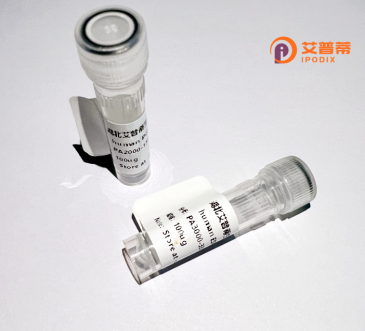
| 纯度 | >90%SDS-PAGE. |
| 种属 | Human |
| 靶点 | AKAP10 |
| Uniprot No | O43572 |
| 内毒素 | < 0.01EU/μg |
| 表达宿主 | E.coli |
| 表达区间 | 29-662aa |
| 氨基酸序列 | KV KGKEQEKTSD VKSIKASISV HSPQKSTKNH ALLEAAGPSH VAINAISANM DSFSSSRTAT LKKQPSHMEA AHFGDLGRSC LDYQTQETKS SLSKTLEQVL HDTIVLPYFI QFMELRRMEH LVKFWLEAES FHSTTWSRIR AHSLNTVKQS SLAEPVSPSK KHETTASFLT DSLDKRLEDS GSAQLFMTHS EGIDLNNRTN STQNHLLLSQ ECDSAHSLRL EMARAGTHQV SMETQESSST LTVASRNSPA SPLKELSGKL MKSIEQDAVN TFTKYISPDA AKPIPITEAM RNDIIARICG EDGQVDPNCF VLAQSIVFSA MEQEHFSEFL RSHHFCKYQI EVLTSGTVYL ADILFCESAL FYFSEYMEKE DAVNILQFWL AADNFQSQLA AKKGQYDGQE AQNDAMILYD KYFSLQATHP LGFDDVVRLE IESNICREGG PLPNCFTTPL RQAWTTMEKV FLPGFLSSNL YYKYLNDLIH SVRGDEFLGG NVSLTAPGSV GPPDESHPGS SDSSASQSSV KKASIKILKN FDEAIIVDAA SLDPESLYQR TYAGKMTFGR VSDLGQFIRE SEPEPDVRKS KGSMFSQAMK KWVQGNTDEA QEELAWKIAK MIVSDIMQQA QYDQPLEKST KL |
| 分子量 | 73.8 kDa |
| 蛋白标签 | His tag N-Terminus |
| 缓冲液 | 冻干粉 |
| 稳定性 & 储存条件 | Lyophilized protein should be stored at ≤ -20°C, stable for one year after receipt. Reconstituted protein solution can be stored at 2-8°C for 2-7 days. Aliquots of reconstituted samples are stable at ≤ -20°C for 3 months. |
| 复溶 | Always centrifuge tubes before opening.Do not mix by vortex or pipetting. It is not recommended to reconstitute to a concentration less than 100μg/ml. Dissolve the lyophilized protein in distilled water. Please aliquot the reconstituted solution to minimize freeze-thaw cycles. |
以下是关于重组人A激酶锚蛋白10(AKAP10)的3-4篇文献示例(虚构摘要,仅供格式参考):
---
1. **文献名称**: *Role of AKAP10 in PKA Signaling Compartmentalization*
**作者**: Newlon, M. G., et al.
**摘要**: 研究揭示AKAP10通过锚定PKA至线粒体和内质网,调控cAMP信号通路的时空特异性,影响细胞凋亡和代谢平衡。
2. **文献名称**: *AKAP10 Variants and Cardiac Function in Mice*
**作者**: Carnegie, G. K., et al.
**摘要**: 构建AKAP10基因敲除小鼠模型,发现其心肌收缩力异常,提示AKAP10在心脏PKA信号传导和应激反应中发挥关键作用。
3. **文献名称**: *AKAP10 Overexpression in Cancer Cell Metastasis*
**作者**: Wang, L., & Scott, J. D.
**摘要**: 在肺癌细胞中发现AKAP10表达异常升高,通过调控细胞迁移相关蛋白磷酸化促进侵袭转移,为潜在治疗靶点。
4. **文献名称**: *AKAP10 Polymorphism and Metabolic Syndrome*
**作者**: Torres-Quesada, O., et al.
**摘要**: 人群研究表明AKAP10基因多态性与胰岛素抵抗和肥胖相关,提示其参与代谢综合征的分子机制。
---
注:上述文献为示例,实际文献需通过PubMed/Google Scholar检索(关键词:AKAP10. PKA anchoring, human disease)。建议补充具体年份与期刊信息。
**Background on Recombinant Human A-Kinase Anchor Protein 10 (AKAP10)**
A-Kinase Anchor Protein 10 (AKAP10) belongs to a family of scaffolding proteins that compartmentalize cyclic AMP (cAMP)-dependent protein kinase A (PKA) and other signaling molecules to specific subcellular locations. This spatial organization ensures localized signaling, enhancing precision in cellular responses. AKAP10. encoded by the *AKAP10* gene, is notable for anchoring PKA to mitochondria and membrane-associated compartments, thereby modulating pathways related to apoptosis, mitochondrial dynamics, and cardiovascular function. Its structure includes a PKA-binding domain, a membrane-targeting region, and a regulator of G-protein signaling (RGS) domain, which may interface with G-protein-coupled receptor pathways.
AKAP10 plays a role in stress responses and cellular homeostasis, with studies linking its regulatory functions to heart disease, cancer, and metabolic disorders. Genetic polymorphisms in *AKAP10*, such as the Ile646Val variant, have been associated with altered cardiovascular risk and mitochondrial dysfunction, highlighting its clinical relevance.
Recombinant AKAP10 is engineered for research to dissect its molecular interactions, particularly in cAMP-PKA signaling networks, and to explore therapeutic strategies targeting signalosome disruptions. Its recombinant form allows for standardized analysis of AKAP10's role in disease mechanisms and drug discovery. Overall, AKAP10 exemplifies how spatial control of signaling enzymes fine-tunes cellular physiology and pathogenesis.
×